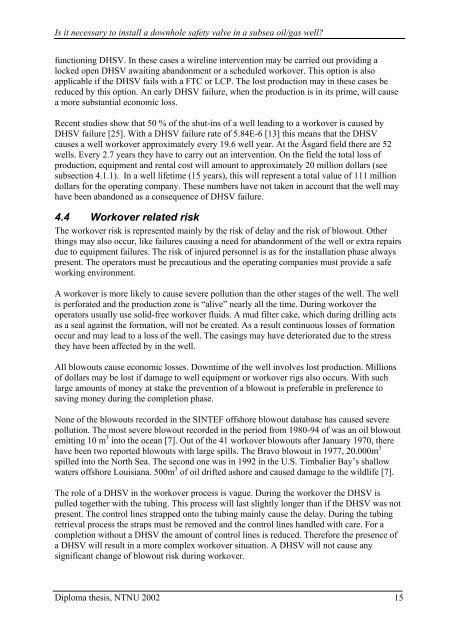Is it necessary to install a downhole safety valve in a subsea ... - NTNU
Is it necessary to install a downhole safety valve in a subsea ... - NTNU
Is it necessary to install a downhole safety valve in a subsea ... - NTNU
Create successful ePaper yourself
Turn your PDF publications into a flip-book with our unique Google optimized e-Paper software.
<strong>Is</strong> <strong>it</strong> <strong>necessary</strong> <strong>to</strong> <strong><strong>in</strong>stall</strong> a <strong>downhole</strong> <strong>safety</strong> <strong>valve</strong> <strong>in</strong> a <strong>subsea</strong> oil/gas well?<br />
function<strong>in</strong>g DHSV. In these cases a wirel<strong>in</strong>e <strong>in</strong>tervention may be carried out provid<strong>in</strong>g a<br />
locked open DHSV awa<strong>it</strong><strong>in</strong>g abandonment or a scheduled workover. This option is also<br />
applicable if the DHSV fails w<strong>it</strong>h a FTC or LCP. The lost production may <strong>in</strong> these cases be<br />
reduced by this option. An early DHSV failure, when the production is <strong>in</strong> <strong>it</strong>s prime, will cause<br />
a more substantial economic loss.<br />
Recent studies show that 50 % of the shut-<strong>in</strong>s of a well lead<strong>in</strong>g <strong>to</strong> a workover is caused by<br />
DHSV failure [25]. W<strong>it</strong>h a DHSV failure rate of 5.84E-6 [13] this means that the DHSV<br />
causes a well workover approximately every 19.6 well year. At the Åsgard field there are 52<br />
wells. Every 2.7 years they have <strong>to</strong> carry out an <strong>in</strong>tervention. On the field the <strong>to</strong>tal loss of<br />
production, equipment and rental cost will amount <strong>to</strong> approximately 20 million dollars (see<br />
subsection 4.1.1). In a well lifetime (15 years), this will represent a <strong>to</strong>tal value of 111 million<br />
dollars for the operat<strong>in</strong>g company. These numbers have not taken <strong>in</strong> account that the well may<br />
have been abandoned as a consequence of DHSV failure.<br />
4.4 Workover related risk<br />
The workover risk is represented ma<strong>in</strong>ly by the risk of delay and the risk of blowout. Other<br />
th<strong>in</strong>gs may also occur, like failures caus<strong>in</strong>g a need for abandonment of the well or extra repairs<br />
due <strong>to</strong> equipment failures. The risk of <strong>in</strong>jured personnel is as for the <strong><strong>in</strong>stall</strong>ation phase always<br />
present. The opera<strong>to</strong>rs must be precautious and the operat<strong>in</strong>g companies must provide a safe<br />
work<strong>in</strong>g environment.<br />
A workover is more likely <strong>to</strong> cause severe pollution than the other stages of the well. The well<br />
is perforated and the production zone is “alive” nearly all the time. Dur<strong>in</strong>g workover the<br />
opera<strong>to</strong>rs usually use solid-free workover fluids. A mud filter cake, which dur<strong>in</strong>g drill<strong>in</strong>g acts<br />
as a seal aga<strong>in</strong>st the formation, will not be created. As a result cont<strong>in</strong>uous losses of formation<br />
occur and may lead <strong>to</strong> a loss of the well. The cas<strong>in</strong>gs may have deteriorated due <strong>to</strong> the stress<br />
they have been affected by <strong>in</strong> the well.<br />
All blowouts cause economic losses. Downtime of the well <strong>in</strong>volves lost production. Millions<br />
of dollars may be lost if damage <strong>to</strong> well equipment or workover rigs also occurs. W<strong>it</strong>h such<br />
large amounts of money at stake the prevention of a blowout is preferable <strong>in</strong> preference <strong>to</strong><br />
sav<strong>in</strong>g money dur<strong>in</strong>g the completion phase.<br />
None of the blowouts recorded <strong>in</strong> the SINTEF offshore blowout database has caused severe<br />
pollution. The most severe blowout recorded <strong>in</strong> the period from 1980-94 of was an oil blowout<br />
em<strong>it</strong>t<strong>in</strong>g 10 m 3 <strong>in</strong><strong>to</strong> the ocean [7]. Out of the 41 workover blowouts after January 1970, there<br />
have been two reported blowouts w<strong>it</strong>h large spills. The Bravo blowout <strong>in</strong> 1977, 20.000m 3<br />
spilled <strong>in</strong><strong>to</strong> the North Sea. The second one was <strong>in</strong> 1992 <strong>in</strong> the U.S. Timbalier Bay’s shallow<br />
waters offshore Louisiana. 500m 3 of oil drifted ashore and caused damage <strong>to</strong> the wildlife [7].<br />
The role of a DHSV <strong>in</strong> the workover process is vague. Dur<strong>in</strong>g the workover the DHSV is<br />
pulled <strong>to</strong>gether w<strong>it</strong>h the tub<strong>in</strong>g. This process will last slightly longer than if the DHSV was not<br />
present. The control l<strong>in</strong>es strapped on<strong>to</strong> the tub<strong>in</strong>g ma<strong>in</strong>ly cause the delay. Dur<strong>in</strong>g the tub<strong>in</strong>g<br />
retrieval process the straps must be removed and the control l<strong>in</strong>es handled w<strong>it</strong>h care. For a<br />
completion w<strong>it</strong>hout a DHSV the amount of control l<strong>in</strong>es is reduced. Therefore the presence of<br />
a DHSV will result <strong>in</strong> a more complex workover s<strong>it</strong>uation. A DHSV will not cause any<br />
significant change of blowout risk dur<strong>in</strong>g workover.<br />
Diploma thesis, <strong>NTNU</strong> 2002<br />
15


